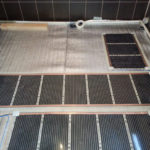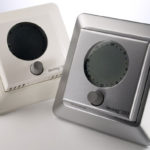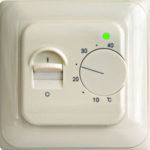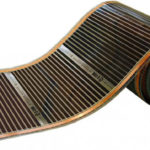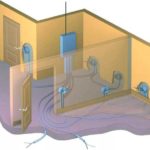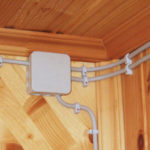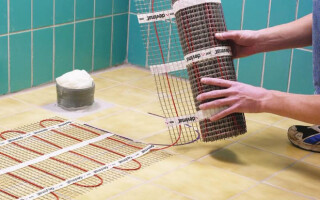Heating and preserving heat in the living space - a pressing issue today. The floor surface of the kitchen, bathroom, bathroom or hallway is most often a cool ceramic coating. In summer this factor can be nice, but in winter the cold floor becomes a problem, especially for families with young children. Electric underfloor heating is an acceptable method of solving this issue. It is not difficult to install heated floors yourself, if you know the basic techniques of how to lay under the tile heating elements.
Contents
What are the options
The high heat output of ceramic tile is its advantage in floor heating in any way.
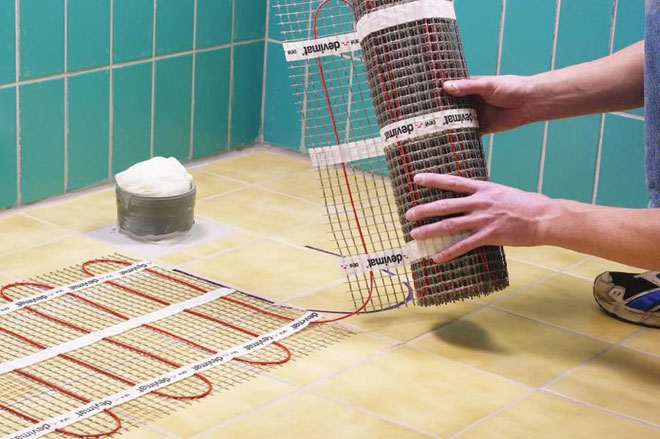
The arrangement of electric flooring can be of several types:
- cable;
- film;
- heating mats;
- rod.
With the cable method, installation of electric underfloor heating under the tiles consists of laying a heating resistive cable, which is attached with special clips on the strips. A cheaper cable is a single-core cable, but more often a double-core cable is used, which has high reliability. Sometimes a cable with a polymer matrix between two conductors that produce heat is used.
You can buy ready-made kits for this method of heating, the price of which depends on the components, length and power of the cable. A complete set of kits may even contain tools. It is more economical to independently select the elements of heating and install a warm floor with your own hands.
Infrared film method - expensive, but the safest method, which uses a flexible polymer fabric with built-in infrared heating elements.
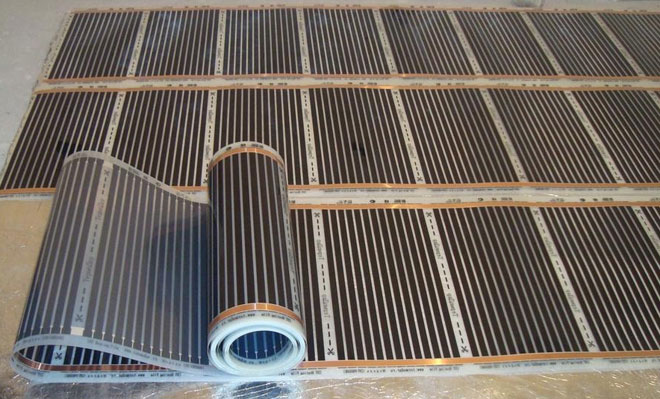
Heating mats consist of a mounting grid with a cable attached to it. Their laying does not require the use of pouring concrete mixture, which increases the load on the ceiling and reduces the height of the ceiling. The method is easy to install, so it is very popular. The final choice of floor heating under the tile is associated with the calculation of the optimal heat transfer. In this case, the calculation of the heating capacity of mats is much easier than the length of heating cables.
The rod method uses carbon rods connected in series. The installation kit includes rod mats, wires and connection kits, and other elements (thermostat, thermal insulation, bitumen insulation, adhesive tape, etc.) are bought separately.
Surface preparation
The technology of installation of underfloor heating requires thorough preparation of the surface before laying the heating elements. Heating mats or cables can only be laid on a clean and level floor without protrusions or cracks. It is possible to use primer, concrete screed or filler floor.
Thermal insulation of the surface
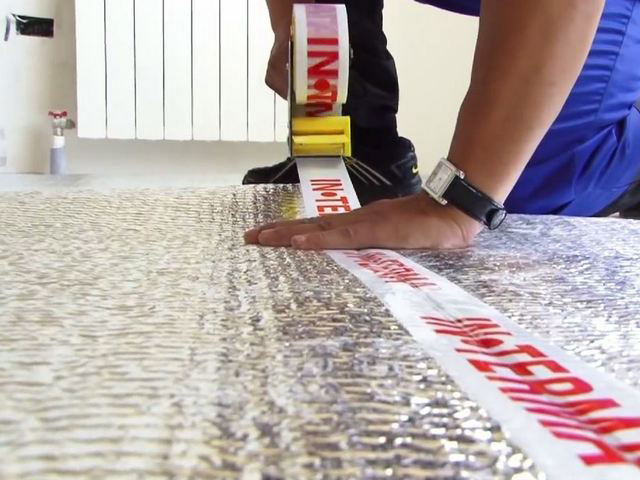
To minimize heat loss and achieve effective heating of the room, a thermal insulation layer is used in preparation. Depending on the required thickness of the insulation, the following materials are used:
- Styrofoam;
- expanded polystyrene;
- foil-coated polystyrene foam.
On balconies, loggias, over unheated rooms or basements use thick insulation materials up to 100 mm (such as foamed plastic and polystyrene foam). For a thin layer of insulation use foil-coated foil (reflective surface of the foil should be directed upwards). All joints and seams are sealed with foil tape. Floor heating under the tiles in the bathroom is additionally equipped with a layer of waterproofing.
Scheme development
Before installing the heating system, it is necessary to develop a plan-scheme on paper. In it the buffer zones with solid furniture, appliances, heating batteries and pipes are separated. Heating systems should not be laid under furniture or appliances as this places additional stress on the cable (the cable overheats because the heat cannot escape upwards).
It turns out an irregular polygon, inscribed in the rectangle of the room. The outline of the future electric floor, power supply and location of the thermostat on the wall (at a height of about one meter) are marked on the diagram. It is also necessary to indent from the walls to 20 cm and to calculate that the distance between the coils of cable is not less than 10 cm. From the paper drawing the markings are transferred to the prepared floor surface. A properly designed circuit will reduce the cost of purchasing a heating system and protect the cable from overheating.
Material calculation
The required power density of the cable is calculated on the basis of the floor area to be covered by the heating system. Before purchasing the materials, you need to make a calculation of the heating area and the cable wattage. All measurements can be done with the help of a computer programme, or you can use the services of a sales clerk. On your own, you can calculate the cable length by multiplying the surface area to be heated by the selected specific power and dividing the result by the cable power.
Depending on the room characteristics the power consumption of an electric floor can range from 100 to 180 Watt/m². A dry, heated room which is heated from another source will require up to 120 Watt/m². If the humidity is high, e.g. in a bathroom, up to 150 Watt/m² is used. On a balcony, a loggia or in an unheated room, the power can be up to 180 watts/m². Underfloor heating under tiles can be the main source of heat, this affects the specific power of the heated room.
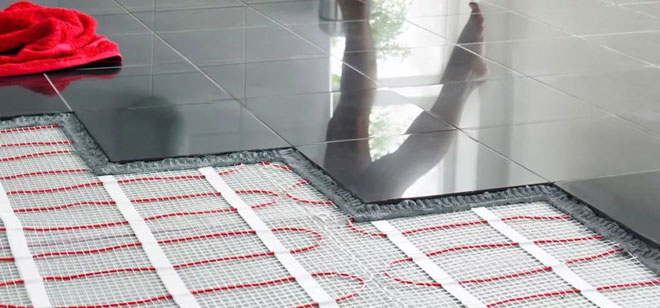
Cable laying step is calculated as follows: multiply the required specific heating power by 100 and divide by the power of the cable. The calculations are made in such a way as to avoid cutting the cable later on (this is strictly forbidden). When using a single-core wire, it is necessary to take into account that its end must return to the beginning of the installation, thereby increasing its length. For laying heating mats, the cable pitch does not need to be calculated. The capacity of the system is calculated by the heating area.
Checking the wiring
Electric underfloor heating under the tiles involves a lot of energy consumption. Before installing it, it is necessary to check whether the existing wiring is suitable for the new load. If, when calculating the cable cross section, it is found that the core diameter does not meet the requirements, it is replaced. It is forbidden to connect the heating system to an outlet. The best option is to run an additional line of electrical wiring to the switchboard.
When designing electrical wiring, the capacity of household electrical appliances is taken into account. If the power consumption exceeds 2 kW, they must be connected to separate fuse boxes. To protect the electrical insulation used RCD device that operates at a rated current of up to 30 mA. Earthing conductors connected to large metal objects are used in rooms with high humidity.
Mounting the Temperature Sensor
Particular attention should be paid to the rules of connection of the temperature controller and temperature sensor. The thermostat is the control unit of the electric floor and processes the information from the heat sensor and switches the heating off and on. The regulator can be programmable or without a set program; it is mounted on the wall at a height of about one meter in an accessible place.
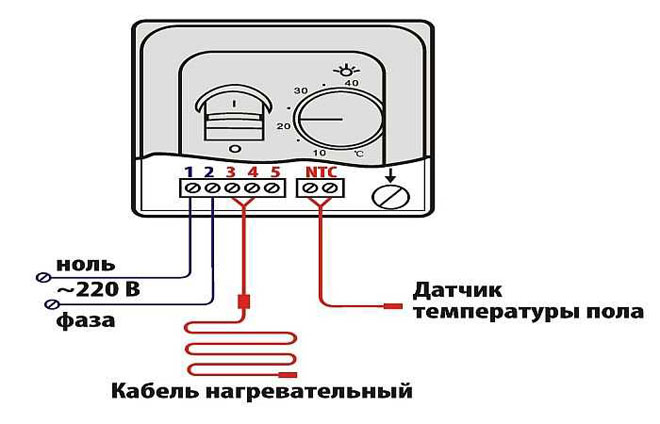
The cable connecting the regulator to the heating system is placed in a corrugated tube and a special pipe. The wire from the thermostat is connected to the heat sensor placed at a distance of up to 40 cm from the wall between the cable coils. The conduit should be laid without kinks; its connection edge with the heating system is insulated with sealant to prevent penetration of the mortar used in the screed. The temperature sensor shall also be installed in a corrugated sleeve to allow it to be accessed if repairs are required.
Installing the cable or thermo mat
Before you start installing the cable floor heating, it is necessary to measure the resistance of the cable. The cable is laid in a loop at a calculated distance (not less than 10 cm) using a special fixing tape. Sometimes a reinforcing mesh is installed, to which the cable is fixed with plastic clamps. To strengthen the cable snake, you can use mounting strips with holes. You must give up to 20 cm distance from the walls.
When installing a single-core cable, it is necessary to lead its end to the initial place of installation, without crossing the other coils. In a two-core cable, one wire serves as a source of heat, the second one closes the circuit, so the end of the cable is made a connection sleeve. Cable is installed after preparing the surface, laying thermal insulation (and waterproofing if necessary) and a small layer of concrete screed. Sometimes the cable is laid directly into the concrete screed. The assembly of the heating surface circuit is made perpendicular to the wall, on which the thermostat is located.
Mesh thermal mats consist of a thin cable fixed to a mesh of glass fiber. Mats can be installed without a preliminary concrete screed, laying them in tile adhesive, increasing its thickness to 10 cm. There are models of thermal mats that have a self-adhesive bottom surface, which is enough to press to the floor for reliable fixation. Mats with an elastic base can be stretched for a complex configuration of the heating scheme.
Heating mats are easier to install than cable heating mats: no need to calculate the pitch between coils, no cable kinks. Nevertheless, it is necessary to know how to properly install underfloor heating under the tile with this method. Mats should be attached to the layer of insulation with tape, keeping the distance between the heating fragments to 10 cm and about 20 cm from the wall. When making turns, the mats can be trimmed without touching the cable and make the necessary turns. After installation, the electrical system should be tested for resistance.
Pouring the screed and laying the tiles
The installation of electric floor heating is completed by applying a protective layer. This can be a concrete floor screed or a poured floor. Most often, a special adhesive mixture is used for the direct installation of ceramic tiles. The thickness of the layer of screed or glue should be from 3 to 5 cm. Sometimes the adhesive layer is applied twice: first the mats or cable loops are covered, then the next layer for laying tiles is applied.
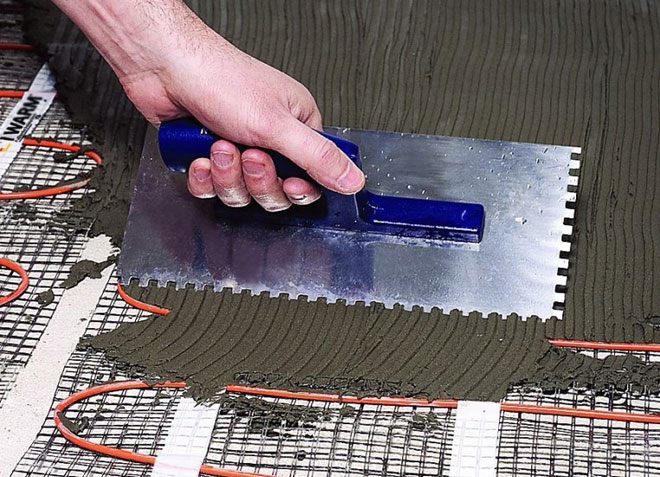
Glue for ceramic tiles should be designed for warm bases, such mixes are sold with special markings or with an indication of the temperature range in operation. Application of adhesive to the heating part should not provoke mechanical damage and air voids. The layer of tile adhesive should be 3 times the diameter of the heating wire. Operate the floor when the screed and glue are completely dry.
Related articles:
